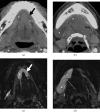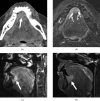Imaging the oral cavity: key concepts for the radiologist
- PMID: 21933981
- PMCID: PMC3473765
- DOI: 10.1259/bjr/70520972
Imaging the oral cavity: key concepts for the radiologist
Abstract
The oral cavity is a challenging area for radiological diagnosis. Soft-tissue, glandular structures and osseous relations are in close proximity and a sound understanding of radiological anatomy and common pathways of disease spread is required. In this pictorial review we present the anatomical and pathological concepts of the oral cavity with emphasis on the complementary nature of diagnostic imaging modalities.
Figures





















References
-
- MacDonald AJ, Harnsberger HR. Oral cavity anatomy and imaging issues. Harnsberger HR, Wiggins RH, Hudgins PA, Michel MA, Swartz J, Davidson HC, et al.,eds. Diagnostic imaging: head and neck. Salt Lake City, UT: Amirsys; 2004;III-:42–5
-
- Smoker WRK. The oral cavity. Som PM, Curtin HD, eds. Head and neck imaging, 4th edn. St Louis, MO. Mosby: 2003:1377–1464
-
- Harnsberger HR. Saint Louis, MO: Mosby: 1995. Handbook of head and neck imaging. 2nd edn.
-
- McMinn RMH, ed. Last's anatomy: regional and applied. New York, NY, USA, Churchill Livingstone; 1994
-
- Stambuk HE, Karimi S, Lee N, Patel SG. Oral cavity and oropharynx tumours. Radiol Clin N Am 2007;45:1–20 - PubMed
Publication types
MeSH terms
LinkOut - more resources
Full Text Sources
Medical

